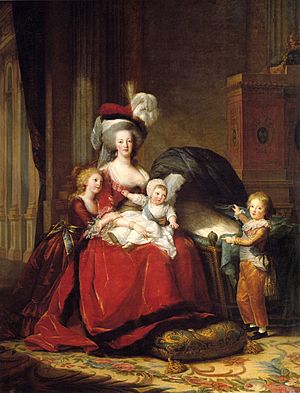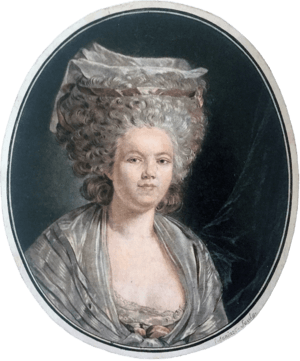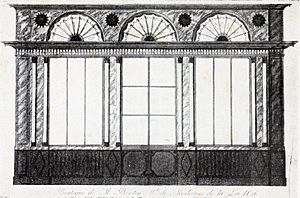Rose Bertin facts for kids
Marie-Jeanne Rose Bertin (born July 2, 1747, in Abbeville, France – died September 22, 1813, in Épinay-sur-Seine) was a famous French milliner. She was best known as the personal dressmaker to Queen Marie Antoinette. Rose Bertin was the first well-known French fashion designer. Many people say she helped bring fashion and haute couture (high fashion) into the spotlight.
Contents
Rose Bertin's Life Story
Rose Bertin grew up in St Gilles, Picardie. Her family was not wealthy. Her mother worked as a nurse, which paid very little. After her father died, their financial situation became even harder. Rose and her brother, Jean-Laurent, had a simple education but big dreams.
Starting Her Fashion Career
When she was sixteen, Rose Bertin moved to Paris. There, she became an apprentice to a successful milliner named Mademoiselle Pagelle. This shop had many rich clients from the aristocracy. Rose Bertin became successful early on because she had good connections. She knew important people like the Princesse de Conti and the Duchesse de Chartres. These connections later helped her meet Queen Marie Antoinette. After getting a large order for Pagelle, Rose became her business partner.
In 1770, Bertin opened her own dress shop called Le Grand Mogol. It was on the Rue Saint-Honoré. The Duchesse de Chartres helped her open the shop. Soon, many important noblewomen from Versailles became her customers. Many of them had followed her from Mademoiselle Pagelle's shop. This included ladies who worked for the new Dauphine, Marie Antoinette.
Dressmaker to the Queen

Versailles, Musée national du Château et des Trianons
Before Marie Antoinette came to France from Austria, she learned about French language and fashion. She met Rose Bertin in 1772. After Louis XVI became king, Bertin would show her new designs to the queen twice a week. They would spend hours talking about them. The queen loved her clothes and cared about every detail. Bertin became her trusted friend and fashion designer. Being the queen's designer also made her the top fashion designer for the French nobility. Since French fashion led Europe, Bertin became a central figure in European fashion.
Some people called Bertin the "Minister of Fashion." She designed almost every new dress for the queen. Dresses and hairstyles became Marie Antoinette's way of showing her personality. Bertin dressed the queen from 1770 until 1792. Bertin became very important at court. Her large, fancy gowns made the wearer take up a lot of space. This made women seem more powerful. Her designs also made France the center of the fashion world. Dresses made in Paris were sent to London, Venice, Vienna, Saint Petersburg, and Constantinople. This unique Parisian style made French fashion famous worldwide.
In the mid-1700s, French women started to "pouf" (raise) their hair. They used pads and pomade. They also wore very large, luxurious gowns. Bertin used and made these styles even bigger. She created poufs for Marie Antoinette that were up to three feet high! The pouf style became so extreme that it was a trademark of the time. Hair was also decorated with ornaments and objects that showed current events.
Working with Léonard Autié, the queen's hairdresser, Bertin created a hairstyle that became popular across Europe. Hair would be styled, cut into scenes, and shaped into objects. These could be anything from recent gossip to French navy ships, like the Belle Poule. The queen's most famous hairstyle was the "inoculation" pouf. She wore it to show that she had convinced the king to get vaccinated against smallpox.
Clothing had long shown social status in France. Marie Antoinette was known for wearing many new, groundbreaking fashions. Bertin came up with the idea of the chemise à la Reine or robe “en Gaulle”. This was a more flowing gown. It was first made for Marie Antoinette and became one of her favorite styles. This dress started a small revolution in fashion and became very popular from 1781. It was a gown meant for private wear. It was made of white cotton, gauze, or silk. It was straight, had a low neckline, and was tied with a belt at the waist. This gently showed off the female figure. Antoinette and Bertin also made English-inspired, sporty fashion popular. All the dresses were made of expensive fabrics like silk and velvet. Creating these masterpieces took a lot of hard work.
Marie Antoinette also asked Bertin to dress dolls in the latest fashions. These were gifts for her sisters and her mother, Empress Maria Theresa of Austria. Bertin's fashion dolls were called "Pandores." They were made of wax over jointed wooden frames or porcelain. There were small ones, like common toy dolls. There were also large ones, as big or half as big as a real person. These were called petites Pandores and grandes Pandores. Fashion dolls were used to show new styles until fashion magazines became popular.
With the queen's support, Bertin's name became linked with the fancy and sometimes over-the-top style of Versailles. Bertin's close relationship with the queen showed how important fashion was at the French court. However, the frequent meetings between the queen and her designer were not popular with everyone. Bertin's prices were very high. Her gowns and headdresses could easily cost twenty times what a skilled worker earned in a year.
During Marie Antoinette's time in prison, Bertin still received orders from her. These were for much smaller things, like ribbons, and simple changes to clothes. She even provided the former queen's mourning outfit after Louis XVI was executed.
The French Revolution and Beyond
The French Revolution did not immediately hurt Bertin's business. Many of her clients moved abroad, but she still had the queen's favor. However, the bills were much lower.
Bertin traveled abroad several times during the Revolution. She went to England and Germany in 1791–92. Officially, these were business trips. She was noted to be at the French émigré court in Koblenz, Germany, in July 1791. She was said to have helped with the fancy fashion of the women there.
Bertin was not in France during the September Massacres. This led to her being put on a list of people who had left the country. She managed to get her name removed from the list. She returned to France in December 1792 to take care of her business.
In February 1793, Rose Bertin left France for London. For a while, she could serve her old clients who had moved abroad. Her fashion dolls continued to be sent to European capitals, even as far as Saint Petersburg. During these years, her main income came from collecting payments from her old foreign clients, like the queen of Sweden. Her business in Paris still ran, even though she was away. She sent money to it from London and still delivered orders to Marie Antoinette.
Later Years
In January 1795, Rose Bertin got her name removed from the list of émigrés. Her lawyer said she had left the country legally for business. She was then free to return and restart her business.
Her business never fully recovered, but it continued on a smaller scale. This was partly because of rising prices and partly because fashions changed after the French Revolution. Joséphine de Beauharnais was one of her clients. She also had foreign clients like Maria Theresa of Naples and Sicily (in 1799) and Maria Luisa of Parma (in 1808). Eventually, another designer, Louis Hippolyte Leroy, became the leading fashion designer.
As the 1800s began, Bertin gave her business to her nephews. She retired to her home in Épinay. She passed away in 1813 in Épinay-sur-Seine.
A Famous Quote
Rose Bertin is said to have told Marie Antoinette in 1785, when showing her a redesigned dress, "Il n'y a de nouveau que ce qui est oublié" ("There is nothing new except what has been forgotten").
See also
 In Spanish: Rose Bertin para niños
In Spanish: Rose Bertin para niños
- Le Sieur Beaulard
- Mademoiselle Alexandre
- Madame Eloffe
- Marie Madeleine Duchapt



